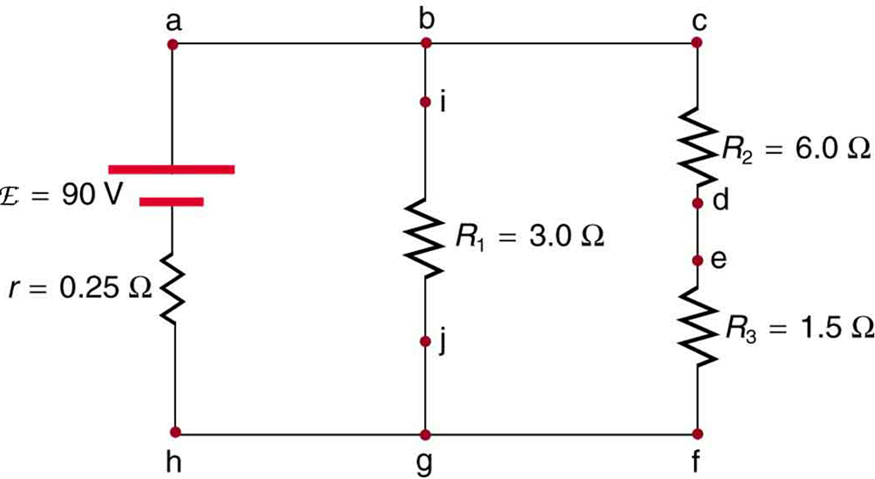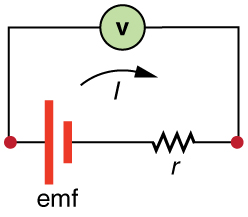| << Chapter < Page | Chapter >> Page > |
Specify the points to which you could connect a voltmeter to measure the following potential differences in [link] : (a) the potential difference of the voltage source; (b) the potential difference across ; (c) across ; (d) across ; (e) across and . Note that there may be more than one answer to each part.

To measure currents in [link] , you would replace a wire between two points with an ammeter. Specify the points between which you would place an ammeter to measure the following: (a) the total current; (b) the current flowing through ; (c) through ; (d) through . Note that there may be more than one answer to each part.
What is the sensitivity of the galvanometer (that is, what current gives a full-scale deflection) inside a voltmeter that has a resistance on its 30.0-V scale?
What is the sensitivity of the galvanometer (that is, what current gives a full-scale deflection) inside a voltmeter that has a resistance on its 100-V scale?
Find the resistance that must be placed in series with a galvanometer having a sensitivity (the same as the one discussed in the text) to allow it to be used as a voltmeter with a 0.100-V full-scale reading.
Find the resistance that must be placed in series with a galvanometer having a sensitivity (the same as the one discussed in the text) to allow it to be used as a voltmeter with a 3000-V full-scale reading. Include a circuit diagram with your solution.
Find the resistance that must be placed in parallel with a galvanometer having a sensitivity (the same as the one discussed in the text) to allow it to be used as an ammeter with a 10.0-A full-scale reading. Include a circuit diagram with your solution.
Find the resistance that must be placed in parallel with a galvanometer having a sensitivity (the same as the one discussed in the text) to allow it to be used as an ammeter with a 300-mA full-scale reading.
Find the resistance that must be placed in series with a galvanometer having a sensitivity to allow it to be used as a voltmeter with: (a) a 300-V full-scale reading, and (b) a 0.300-V full-scale reading.
(a)
(b)
Find the resistance that must be placed in parallel with a galvanometer having a sensitivity to allow it to be used as an ammeter with: (a) a 20.0-A full-scale reading, and (b) a 100-mA full-scale reading.
Suppose you measure the terminal voltage of a 1.585-V alkaline cell having an internal resistance of by placing a voltmeter across its terminals. (See [link] .) (a) What current flows? (b) Find the terminal voltage. (c) To see how close the measured terminal voltage is to the emf, calculate their ratio.

(a) 1.58 mA
(b) 1.5848 V (need four digits to see the difference)
(c) 0.99990 (need five digits to see the difference from unity)
Suppose you measure the terminal voltage of a 3.200-V lithium cell having an internal resistance of by placing a voltmeter across its terminals. (a) What current flows? (b) Find the terminal voltage. (c) To see how close the measured terminal voltage is to the emf, calculate their ratio.
A certain ammeter has a resistance of on its 3.00-A scale and contains a galvanometer. What is the sensitivity of the galvanometer?
A voltmeter is placed in parallel with a resistor in a circuit. (a) Draw a circuit diagram of the connection. (b) What is the resistance of the combination? (c) If the voltage across the combination is kept the same as it was across the resistor alone, what is the percent increase in current? (d) If the current through the combination is kept the same as it was through the resistor alone, what is the percentage decrease in voltage? (e) Are the changes found in parts (c) and (d) significant? Discuss.
A ammeter is placed in series with a resistor in a circuit. (a) Draw a circuit diagram of the connection. (b) Calculate the resistance of the combination. (c) If the voltage is kept the same across the combination as it was through the resistor alone, what is the percent decrease in current? (d) If the current is kept the same through the combination as it was through the resistor alone, what is the percent increase in voltage? (e) Are the changes found in parts (c) and (d) significant? Discuss.
(a)

(b)
(c) 0.9980, or a percent decrease
(d) 1.002, or a percent increase
(e) Not significant.
Unreasonable Results
Suppose you have a galvanometer with a sensitivity. (a) What resistance would you put in series with it to allow it to be used as a voltmeter that has a full-scale deflection for 0.500 mV? (b) What is unreasonable about this result? (c) Which assumptions are responsible?
Unreasonable Results
(a) What resistance would you put in parallel with a galvanometer having a sensitivity to allow it to be used as an ammeter that has a full-scale deflection for ? (b) What is unreasonable about this result? (c) Which assumptions are responsible?
(a)
(b) You can’t have negative resistance.
(c) It is unreasonable that is greater than (see [link] ). You cannot achieve a full-scale deflection using a current less than the sensitivity of the galvanometer.

Notification Switch
Would you like to follow the 'College physics for ap® courses' conversation and receive update notifications?